Deck 4: Applications of the Derivative
سؤال
سؤال
سؤال
سؤال
سؤال
سؤال
سؤال
سؤال
سؤال
سؤال
سؤال
سؤال
سؤال
سؤال
سؤال
سؤال
سؤال
سؤال
سؤال
سؤال
سؤال
سؤال
سؤال
سؤال
سؤال
سؤال
سؤال
سؤال
سؤال
سؤال
سؤال
سؤال
سؤال
سؤال
سؤال
سؤال
سؤال
سؤال
سؤال
سؤال
سؤال
سؤال
سؤال
سؤال
سؤال
سؤال
سؤال
سؤال
سؤال
سؤال
سؤال
سؤال
سؤال
سؤال
سؤال
سؤال
سؤال
سؤال
سؤال
سؤال
سؤال
سؤال
سؤال
سؤال
سؤال
سؤال
سؤال
سؤال
سؤال
سؤال
سؤال
سؤال
سؤال
سؤال
سؤال
سؤال
سؤال
سؤال
سؤال
سؤال

فتح الحزمة
قم بالتسجيل لفتح البطاقات في هذه المجموعة!
Unlock Deck
Unlock Deck
1/143
العب
ملء الشاشة (f)
Deck 4: Applications of the Derivative
1
Using Newton's method with  , determine the third iteration when approximating the root to at least six-digit accuracy of the following equation. x3 + x2 - 3x + 5 = 0
, determine the third iteration when approximating the root to at least six-digit accuracy of the following equation. x3 + x2 - 3x + 5 = 0
A) -2.777778
B) -2.751101
C) -2.751145
D) -2.751446
 , determine the third iteration when approximating the root to at least six-digit accuracy of the following equation. x3 + x2 - 3x + 5 = 0
, determine the third iteration when approximating the root to at least six-digit accuracy of the following equation. x3 + x2 - 3x + 5 = 0A) -2.777778
B) -2.751101
C) -2.751145
D) -2.751446
-2.751101
2
A certain company estimates that it can sell f(x)-thousand video game consoles at the price of $x as given in the table.  Use a linear approximation to estimate the number of consoles that can be sold at $62.
Use a linear approximation to estimate the number of consoles that can be sold at $62.
A) approximately 106 thousand consoles
B) approximately 109 thousand consoles
C) approximately 131 thousand consoles
D) approximately 139 thousand consoles
 Use a linear approximation to estimate the number of consoles that can be sold at $62.
Use a linear approximation to estimate the number of consoles that can be sold at $62.A) approximately 106 thousand consoles
B) approximately 109 thousand consoles
C) approximately 131 thousand consoles
D) approximately 139 thousand consoles
B
3
Find the limit. 

A) 0
B)
C)
D) limit does not exist


A) 0
B)

C)

D) limit does not exist
C
4
Use a linear approximation to estimate  Note that 16.9 is near 16 which is
Note that 16.9 is near 16 which is 
A) 2.92755
B) 2.02755
C) 2.02812
D) 3.00155
 Note that 16.9 is near 16 which is
Note that 16.9 is near 16 which is 
A) 2.92755
B) 2.02755
C) 2.02812
D) 3.00155

فتح الحزمة
افتح القفل للوصول البطاقات البالغ عددها 143 في هذه المجموعة.
فتح الحزمة
k this deck
5
Using Newton's method with  , determine the second iteration when approximating the root to at least six-digit accuracy of the following equation.
, determine the second iteration when approximating the root to at least six-digit accuracy of the following equation. 
A) 0.885396
B) 0.783253
C) 0.784946
D) 0.783163
 , determine the second iteration when approximating the root to at least six-digit accuracy of the following equation.
, determine the second iteration when approximating the root to at least six-digit accuracy of the following equation. 
A) 0.885396
B) 0.783253
C) 0.784946
D) 0.783163

فتح الحزمة
افتح القفل للوصول البطاقات البالغ عددها 143 في هذه المجموعة.
فتح الحزمة
k this deck
6
Find the linear approximation, L(x), to f(x) at x = x0. f(x) = e7x, x0 = 0
A) L(x) = 7x
B) L(x) = -7x + 1
C) L(x) = 7ex - 1
D) L(x) = 7x + 1
A) L(x) = 7x
B) L(x) = -7x + 1
C) L(x) = 7ex - 1
D) L(x) = 7x + 1

فتح الحزمة
افتح القفل للوصول البطاقات البالغ عددها 143 في هذه المجموعة.
فتح الحزمة
k this deck
7
Use Newton's method with x0 = 2.3 to compute x1 and x2 without the use of a calculator.
f(x) = x3 - 3x - 5
f(x) = x3 - 3x - 5

فتح الحزمة
افتح القفل للوصول البطاقات البالغ عددها 143 في هذه المجموعة.
فتح الحزمة
k this deck
8
Explain why Newton's method fails for the following equation with the specified initial guess. 
A) Using we see that f is not differentiable at
we see that f is not differentiable at 
B) Using we obtain
we obtain  .
.
C) Using we obtain
we obtain  which will give
which will give 
D) Using we see that f does not have any real roots.
we see that f does not have any real roots.

A) Using
 we see that f is not differentiable at
we see that f is not differentiable at 
B) Using
 we obtain
we obtain  .
.C) Using
 we obtain
we obtain  which will give
which will give 
D) Using
 we see that f does not have any real roots.
we see that f does not have any real roots.
فتح الحزمة
افتح القفل للوصول البطاقات البالغ عددها 143 في هذه المجموعة.
فتح الحزمة
k this deck
9
Given the graph of f(x), draw in the tangent lines used in Newton's method to determine x1 and x2 after starting at x0 = 1. 


فتح الحزمة
افتح القفل للوصول البطاقات البالغ عددها 143 في هذه المجموعة.
فتح الحزمة
k this deck
10
The impedance Z of a simple RL (resistive inductive) circuit is given by  , where R is the resistance of the resistor, L is the inductance of the inductor, and is the angular frequency of the applied voltage. Find a linear approximation of Z(L) for small values of L assuming all other quantities are constant. Show all of your work.
, where R is the resistance of the resistor, L is the inductance of the inductor, and is the angular frequency of the applied voltage. Find a linear approximation of Z(L) for small values of L assuming all other quantities are constant. Show all of your work.
 , where R is the resistance of the resistor, L is the inductance of the inductor, and is the angular frequency of the applied voltage. Find a linear approximation of Z(L) for small values of L assuming all other quantities are constant. Show all of your work.
, where R is the resistance of the resistor, L is the inductance of the inductor, and is the angular frequency of the applied voltage. Find a linear approximation of Z(L) for small values of L assuming all other quantities are constant. Show all of your work. 
فتح الحزمة
افتح القفل للوصول البطاقات البالغ عددها 143 في هذه المجموعة.
فتح الحزمة
k this deck
11
Using Newton's method, approximate the root of the following equation to at least six-digit accuracy. 
A) 0.817880
B) 0.839580
C) 0.807714
D) 0.827880

A) 0.817880
B) 0.839580
C) 0.807714
D) 0.827880

فتح الحزمة
افتح القفل للوصول البطاقات البالغ عددها 143 في هذه المجموعة.
فتح الحزمة
k this deck
12
Use a linear approximation to estimate 
A) 0
B) 0.23
C) 0.15
D) 0.07

A) 0
B) 0.23
C) 0.15
D) 0.07

فتح الحزمة
افتح القفل للوصول البطاقات البالغ عددها 143 في هذه المجموعة.
فتح الحزمة
k this deck
13
Find the linear approximation at x = 0 to show that the following commonly used approximation is valid for "small" x. 


فتح الحزمة
افتح القفل للوصول البطاقات البالغ عددها 143 في هذه المجموعة.
فتح الحزمة
k this deck
14
Use Newton's method to find an approximate root of the equation  (accurate to six decimal places).
(accurate to six decimal places).
A) 0.186548
B) 0.136548
C) 0.056548
D) 0.126548
 (accurate to six decimal places).
(accurate to six decimal places).A) 0.186548
B) 0.136548
C) 0.056548
D) 0.126548

فتح الحزمة
افتح القفل للوصول البطاقات البالغ عددها 143 في هذه المجموعة.
فتح الحزمة
k this deck
15
Find the linear approximation, L(x), to f(x) at x = x0. 
A)
B)
C)
D)

A)

B)

C)

D)


فتح الحزمة
افتح القفل للوصول البطاقات البالغ عددها 143 في هذه المجموعة.
فتح الحزمة
k this deck
16
Use linear approximation of  at
at  to estimate the quantity of
to estimate the quantity of  to the nearest ten thousandth.
to the nearest ten thousandth.
A)
B)
C)
D)
 at
at  to estimate the quantity of
to estimate the quantity of  to the nearest ten thousandth.
to the nearest ten thousandth.A)

B)

C)

D)


فتح الحزمة
افتح القفل للوصول البطاقات البالغ عددها 143 في هذه المجموعة.
فتح الحزمة
k this deck
17
Approximate  accurate to 3 decimal places using Newton's method. State the function used.
accurate to 3 decimal places using Newton's method. State the function used.
A) 2.714 using
B) 2.814 using
C) 2.664 using
D) 2.731 using
 accurate to 3 decimal places using Newton's method. State the function used.
accurate to 3 decimal places using Newton's method. State the function used.A) 2.714 using

B) 2.814 using

C) 2.664 using

D) 2.731 using


فتح الحزمة
افتح القفل للوصول البطاقات البالغ عددها 143 في هذه المجموعة.
فتح الحزمة
k this deck
18
Find the linear approximation at x = 0 to show that the following commonly used approximation is valid for "small" x. 


فتح الحزمة
افتح القفل للوصول البطاقات البالغ عددها 143 في هذه المجموعة.
فتح الحزمة
k this deck
19
Using Newton's method, approximate the root of the following equation to at least six-digit accuracy. x3 + x2 - 5x + 5 = 0
A) -3.125000
B) -3.141392
C) -3.117942
D) -3.123872
A) -3.125000
B) -3.141392
C) -3.117942
D) -3.123872

فتح الحزمة
افتح القفل للوصول البطاقات البالغ عددها 143 في هذه المجموعة.
فتح الحزمة
k this deck
20
Find the linear approximation, L(x), to f(x) at x = x0. 
A)
B)
C)
D)

A)

B)

C)

D)


فتح الحزمة
افتح القفل للوصول البطاقات البالغ عددها 143 في هذه المجموعة.
فتح الحزمة
k this deck
21
Find the limit. 

A) 0
B)
C)
D) limit does not exist


A) 0
B)

C)

D) limit does not exist

فتح الحزمة
افتح القفل للوصول البطاقات البالغ عددها 143 في هذه المجموعة.
فتح الحزمة
k this deck
22
Find the error in the following incorrect calculation. 


فتح الحزمة
افتح القفل للوصول البطاقات البالغ عددها 143 في هذه المجموعة.
فتح الحزمة
k this deck
23
Given the graph of  , locate the absolute extrema (if they exist) on the interval
, locate the absolute extrema (if they exist) on the interval  .
. 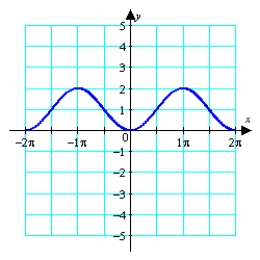
A) absolute max:
Absolute min:
B) absolute min:
C) absolute max:
Absolute min:
D) no absolute extrema
 , locate the absolute extrema (if they exist) on the interval
, locate the absolute extrema (if they exist) on the interval  .
. 
A) absolute max:

Absolute min:

B) absolute min:

C) absolute max:

Absolute min:

D) no absolute extrema

فتح الحزمة
افتح القفل للوصول البطاقات البالغ عددها 143 في هذه المجموعة.
فتح الحزمة
k this deck
24
Find the limit. 
A) 1
B) 3
C)
D)

A) 1
B) 3
C)

D)


فتح الحزمة
افتح القفل للوصول البطاقات البالغ عددها 143 في هذه المجموعة.
فتح الحزمة
k this deck
25
Find the limit. 

A)
B)
C) 0
D) limit does not exist


A)

B)

C) 0
D) limit does not exist

فتح الحزمة
افتح القفل للوصول البطاقات البالغ عددها 143 في هذه المجموعة.
فتح الحزمة
k this deck
26
Determine which function "dominates", where we say that the function f(x) dominates the function g(x) as  if
if  and either
and either  Show all work.
Show all work. 
 if
if  and either
and either  Show all work.
Show all work. 

فتح الحزمة
افتح القفل للوصول البطاقات البالغ عددها 143 في هذه المجموعة.
فتح الحزمة
k this deck
27
Given the graph of  , locate the absolute extrema (if they exist) on the interval
, locate the absolute extrema (if they exist) on the interval  .
. 
A) absolute max: approximately
Absolute min:
B) absolute max:
Absolute min:
C) absolute max:
Absolute min:
D) no absolute extrema
 , locate the absolute extrema (if they exist) on the interval
, locate the absolute extrema (if they exist) on the interval  .
. 
A) absolute max: approximately

Absolute min:

B) absolute max:

Absolute min:

C) absolute max:

Absolute min:

D) no absolute extrema

فتح الحزمة
افتح القفل للوصول البطاقات البالغ عددها 143 في هذه المجموعة.
فتح الحزمة
k this deck
28
Find the limit. 
A) 0
B) 1
C) -3
D) 3

A) 0
B) 1
C) -3
D) 3

فتح الحزمة
افتح القفل للوصول البطاقات البالغ عددها 143 في هذه المجموعة.
فتح الحزمة
k this deck
29
Find the limit. 
A) 1
B)
C)
D)

A) 1
B)

C)

D)


فتح الحزمة
افتح القفل للوصول البطاقات البالغ عددها 143 في هذه المجموعة.
فتح الحزمة
k this deck
30
Find the limit. 
A) 0
B) 1
C)
D)

A) 0
B) 1
C)

D)


فتح الحزمة
افتح القفل للوصول البطاقات البالغ عددها 143 في هذه المجموعة.
فتح الحزمة
k this deck
31
Given the graph of  , locate the absolute extrema (if they exist) on the interval
, locate the absolute extrema (if they exist) on the interval  .
. 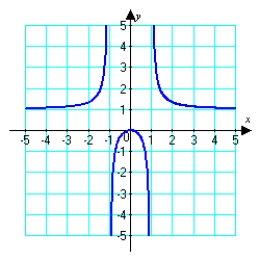
A) absolute max:
B) absolute min: and
and 
C) absolute min:
D) no absolute extrema
 , locate the absolute extrema (if they exist) on the interval
, locate the absolute extrema (if they exist) on the interval  .
. 
A) absolute max:

B) absolute min:
 and
and 
C) absolute min:

D) no absolute extrema

فتح الحزمة
افتح القفل للوصول البطاقات البالغ عددها 143 في هذه المجموعة.
فتح الحزمة
k this deck
32
Find the limit. 

A) 0
B)
C)
D) does not exist


A) 0
B)

C)

D) does not exist

فتح الحزمة
افتح القفل للوصول البطاقات البالغ عددها 143 في هذه المجموعة.
فتح الحزمة
k this deck
33
Suppose the size of a particular animal's pupils expand and contract depending on the amount of light available. Let  be the size in mm of the pupils at light intensity x. Find the smallest possible size of the pupils by finding
be the size in mm of the pupils at light intensity x. Find the smallest possible size of the pupils by finding 
A) 1 mm
B) 5 mm
C) 30 mm
D) mm
mm
 be the size in mm of the pupils at light intensity x. Find the smallest possible size of the pupils by finding
be the size in mm of the pupils at light intensity x. Find the smallest possible size of the pupils by finding 
A) 1 mm
B) 5 mm
C) 30 mm
D)
 mm
mm
فتح الحزمة
افتح القفل للوصول البطاقات البالغ عددها 143 في هذه المجموعة.
فتح الحزمة
k this deck
34
Given the graph of  , locate the absolute extrema (if they exist) on the interval
, locate the absolute extrema (if they exist) on the interval  .
. 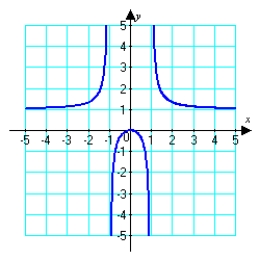
A) absolute max:
B) absolute min:
C) absolute min:
D) no absolute extrema
 , locate the absolute extrema (if they exist) on the interval
, locate the absolute extrema (if they exist) on the interval  .
. 
A) absolute max:

B) absolute min:

C) absolute min:

D) no absolute extrema

فتح الحزمة
افتح القفل للوصول البطاقات البالغ عددها 143 في هذه المجموعة.
فتح الحزمة
k this deck
35
Find the error in the following incorrect calculation. 


فتح الحزمة
افتح القفل للوصول البطاقات البالغ عددها 143 في هذه المجموعة.
فتح الحزمة
k this deck
36
Given the graph of  , locate the absolute extrema (if they exist) on the interval
, locate the absolute extrema (if they exist) on the interval  .
. 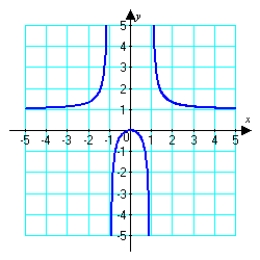
A) absolute max:
B) absolute min: and
and 
C) absolute min:
D) no absolute extrema
 , locate the absolute extrema (if they exist) on the interval
, locate the absolute extrema (if they exist) on the interval  .
. 
A) absolute max:

B) absolute min:
 and
and 
C) absolute min:

D) no absolute extrema

فتح الحزمة
افتح القفل للوصول البطاقات البالغ عددها 143 في هذه المجموعة.
فتح الحزمة
k this deck
37
Given the graph of  , locate the absolute extrema (if they exist) on the interval
, locate the absolute extrema (if they exist) on the interval  .
. 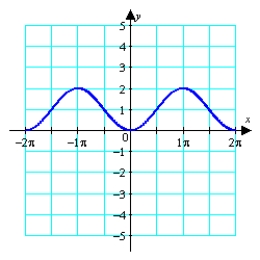
A) absolute max:
Absolute min:
B) absolute max:
Absolute min:
C) absolute max:
Absolute min:
D) no absolute extrema
 , locate the absolute extrema (if they exist) on the interval
, locate the absolute extrema (if they exist) on the interval  .
. 
A) absolute max:

Absolute min:

B) absolute max:

Absolute min:

C) absolute max:

Absolute min:

D) no absolute extrema

فتح الحزمة
افتح القفل للوصول البطاقات البالغ عددها 143 في هذه المجموعة.
فتح الحزمة
k this deck
38
Find the limit. 
A) 0
B) 1
C) 10
D) -10

A) 0
B) 1
C) 10
D) -10

فتح الحزمة
افتح القفل للوصول البطاقات البالغ عددها 143 في هذه المجموعة.
فتح الحزمة
k this deck
39
Given the graph of  , locate the absolute extrema (if they exist) on the interval
, locate the absolute extrema (if they exist) on the interval  .
. 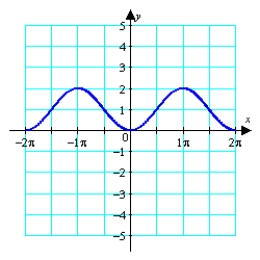
A) absolute max:
Absolute min:
B) absolute min:
C) absolute max:
Absolute min:
D) no absolute extrema
 , locate the absolute extrema (if they exist) on the interval
, locate the absolute extrema (if they exist) on the interval  .
. 
A) absolute max:

Absolute min:

B) absolute min:

C) absolute max:

Absolute min:

D) no absolute extrema

فتح الحزمة
افتح القفل للوصول البطاقات البالغ عددها 143 في هذه المجموعة.
فتح الحزمة
k this deck
40
Find the indicated limit. 

A) 0
B) 1
C)
D) limit does not exist


A) 0
B) 1
C)

D) limit does not exist

فتح الحزمة
افتح القفل للوصول البطاقات البالغ عددها 143 في هذه المجموعة.
فتح الحزمة
k this deck
41
Find the absolute extrema of the given function on the indicated interval.  on
on 
A) absolute maximum: , absolute minimum:
, absolute minimum: 
B) absolute maximum: , absolute minimum:
, absolute minimum: 
C) absolute maximum: , absolute minimum:
, absolute minimum: 
D) absolute maximum: , absolute minimum:
, absolute minimum: 
 on
on 
A) absolute maximum:
 , absolute minimum:
, absolute minimum: 
B) absolute maximum:
 , absolute minimum:
, absolute minimum: 
C) absolute maximum:
 , absolute minimum:
, absolute minimum: 
D) absolute maximum:
 , absolute minimum:
, absolute minimum: 

فتح الحزمة
افتح القفل للوصول البطاقات البالغ عددها 143 في هذه المجموعة.
فتح الحزمة
k this deck
42
Given  , on the interval
, on the interval  , determine the critical number(s).
, determine the critical number(s).
A)
B)
C)
D)
 , on the interval
, on the interval  , determine the critical number(s).
, determine the critical number(s).A)

B)

C)

D)


فتح الحزمة
افتح القفل للوصول البطاقات البالغ عددها 143 في هذه المجموعة.
فتح الحزمة
k this deck
43
Find all critical numbers. Then use a graph to determine whether the critical numbers represent a local maximum, local minimum, or neither. 
A) (local maximum),
(local maximum),  (neither),
(neither),  (local minimum)
(local minimum)
B) (local maximum),
(local maximum),  (local maximum),
(local maximum),  (local minimum)
(local minimum)
C) (local maximum),
(local maximum),  (local minimum)
(local minimum)
D) (local minimum),
(local minimum),  (local maximum)
(local maximum)

A)
 (local maximum),
(local maximum),  (neither),
(neither),  (local minimum)
(local minimum)B)
 (local maximum),
(local maximum),  (local maximum),
(local maximum),  (local minimum)
(local minimum)C)
 (local maximum),
(local maximum),  (local minimum)
(local minimum)D)
 (local minimum),
(local minimum),  (local maximum)
(local maximum)
فتح الحزمة
افتح القفل للوصول البطاقات البالغ عددها 143 في هذه المجموعة.
فتح الحزمة
k this deck
44
Given  , determine the absolute extrema on the interval
, determine the absolute extrema on the interval  .
.
A) absolute max: ; absolute min:
; absolute min: 
B) absolute max: and
and  ; absolute min:
; absolute min:  and
and 
C) absolute max: ; absolute min:
; absolute min: 
D) absolute max: ; absolute min:
; absolute min: 
 , determine the absolute extrema on the interval
, determine the absolute extrema on the interval  .
.A) absolute max:
 ; absolute min:
; absolute min: 
B) absolute max:
 and
and  ; absolute min:
; absolute min:  and
and 
C) absolute max:
 ; absolute min:
; absolute min: 
D) absolute max:
 ; absolute min:
; absolute min: 

فتح الحزمة
افتح القفل للوصول البطاقات البالغ عددها 143 في هذه المجموعة.
فتح الحزمة
k this deck
45
Using a calculator or computer, estimate the absolute extrema of  on the interval
on the interval  . Round answer to the nearest hundredth.
. Round answer to the nearest hundredth.
A) absolute max: ; absolute min:
; absolute min: 
B) absolute max: ; absolute min:
; absolute min: 
C) absolute max: ; absolute min:
; absolute min: 
D) absolute max: ; absolute min:
; absolute min: 
 on the interval
on the interval  . Round answer to the nearest hundredth.
. Round answer to the nearest hundredth.A) absolute max:
 ; absolute min:
; absolute min: 
B) absolute max:
 ; absolute min:
; absolute min: 
C) absolute max:
 ; absolute min:
; absolute min: 
D) absolute max:
 ; absolute min:
; absolute min: 

فتح الحزمة
افتح القفل للوصول البطاقات البالغ عددها 143 في هذه المجموعة.
فتح الحزمة
k this deck
46
Find all critical numbers. Then use the graph to determine whether the critical numbers represent a local maximum, local minimum, or neither. 
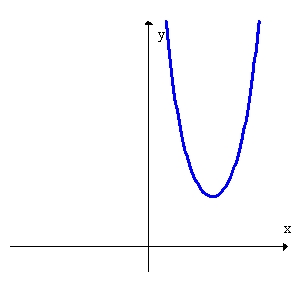
A) , local maximum
, local maximum
B) , local minimum
, local minimum
C) , local minimum
, local minimum
D) , neither
, neither


A)
 , local maximum
, local maximumB)
 , local minimum
, local minimumC)
 , local minimum
, local minimumD)
 , neither
, neither
فتح الحزمة
افتح القفل للوصول البطاقات البالغ عددها 143 في هذه المجموعة.
فتح الحزمة
k this deck
47
Given the graph of  , locate the absolute extrema (if they exist) on the interval
, locate the absolute extrema (if they exist) on the interval  .
. 
A) absolute max: approximately
B) absolute max: approximately
Absolute min:
C) absolute max: approximately
Absolute min:
Absolute min:
D) no absolute extrema
 , locate the absolute extrema (if they exist) on the interval
, locate the absolute extrema (if they exist) on the interval  .
. 
A) absolute max: approximately

B) absolute max: approximately

Absolute min:

C) absolute max: approximately

Absolute min:

Absolute min:

D) no absolute extrema

فتح الحزمة
افتح القفل للوصول البطاقات البالغ عددها 143 في هذه المجموعة.
فتح الحزمة
k this deck
48
Given the graph of  , locate the absolute extrema (if they exist) on the interval
, locate the absolute extrema (if they exist) on the interval  .
. 
A) absolute max: approximately
B) absolute max:
Absolute min:
C) absolute max:
Absolute min:
D) no absolute extrema
 , locate the absolute extrema (if they exist) on the interval
, locate the absolute extrema (if they exist) on the interval  .
. 
A) absolute max: approximately

B) absolute max:

Absolute min:

C) absolute max:

Absolute min:

D) no absolute extrema

فتح الحزمة
افتح القفل للوصول البطاقات البالغ عددها 143 في هذه المجموعة.
فتح الحزمة
k this deck
49
Using a calculator or computer, estimate the absolute extrema of  , on the interval
, on the interval  .
.
A) absolute max: ; absolute min:
; absolute min: 
B) absolute max: ; absolute min:
; absolute min: 
C) absolute max: ; absolute min:
; absolute min: 
D) absolute max: ; absolute min:
; absolute min: 
 , on the interval
, on the interval  .
.A) absolute max:
 ; absolute min:
; absolute min: 
B) absolute max:
 ; absolute min:
; absolute min: 
C) absolute max:
 ; absolute min:
; absolute min: 
D) absolute max:
 ; absolute min:
; absolute min: 

فتح الحزمة
افتح القفل للوصول البطاقات البالغ عددها 143 في هذه المجموعة.
فتح الحزمة
k this deck
50
Given  , on the interval
, on the interval  , determine if the critical number
, determine if the critical number  represents a local maximum, local minimum or neither.
represents a local maximum, local minimum or neither.
A) local maximum
B) local minimum
C) neither
 , on the interval
, on the interval  , determine if the critical number
, determine if the critical number  represents a local maximum, local minimum or neither.
represents a local maximum, local minimum or neither.A) local maximum
B) local minimum
C) neither

فتح الحزمة
افتح القفل للوصول البطاقات البالغ عددها 143 في هذه المجموعة.
فتح الحزمة
k this deck
51
Determine all critical numbers of  .
.
A)
B)
C)
D)
 .
.A)

B)

C)

D)


فتح الحزمة
افتح القفل للوصول البطاقات البالغ عددها 143 في هذه المجموعة.
فتح الحزمة
k this deck
52
Find all critical numbers. 
A)

B) ,
, 
C)

D)


A)


B)
 ,
, 
C)


D)



فتح الحزمة
افتح القفل للوصول البطاقات البالغ عددها 143 في هذه المجموعة.
فتح الحزمة
k this deck
53
Given  , determine the critical number(s).
, determine the critical number(s).
A)
B)
C)
D)
 , determine the critical number(s).
, determine the critical number(s).A)

B)

C)

D)


فتح الحزمة
افتح القفل للوصول البطاقات البالغ عددها 143 في هذه المجموعة.
فتح الحزمة
k this deck
54
Given  determine if the critical number
determine if the critical number  represents a local maximum, local minimum or neither.
represents a local maximum, local minimum or neither.
A) local maximum
B) local minimum
C) neither
 determine if the critical number
determine if the critical number  represents a local maximum, local minimum or neither.
represents a local maximum, local minimum or neither.A) local maximum
B) local minimum
C) neither

فتح الحزمة
افتح القفل للوصول البطاقات البالغ عددها 143 في هذه المجموعة.
فتح الحزمة
k this deck
55
Given  determine the critical number(s).
determine the critical number(s).
A)
B)
C)
D)
 determine the critical number(s).
determine the critical number(s).A)

B)

C)

D)


فتح الحزمة
افتح القفل للوصول البطاقات البالغ عددها 143 في هذه المجموعة.
فتح الحزمة
k this deck
56
Using a calculator or computer, estimate the absolute extrema of  on the interval
on the interval  . Round answer to the nearest hundredth.
. Round answer to the nearest hundredth.
A) absolute max: ; absolute min:
; absolute min: 
B) absolute max: ; absolute min:
; absolute min: 
C) absolute max: ; absolute min:
; absolute min: 
D) absolute max: ; absolute min:
; absolute min: 
 on the interval
on the interval  . Round answer to the nearest hundredth.
. Round answer to the nearest hundredth.A) absolute max:
 ; absolute min:
; absolute min: 
B) absolute max:
 ; absolute min:
; absolute min: 
C) absolute max:
 ; absolute min:
; absolute min: 
D) absolute max:
 ; absolute min:
; absolute min: 

فتح الحزمة
افتح القفل للوصول البطاقات البالغ عددها 143 في هذه المجموعة.
فتح الحزمة
k this deck
57
Given  determine if the critical number
determine if the critical number  represents a local maximum, local minimum or neither.
represents a local maximum, local minimum or neither.
A) local maximum
B) local minimum
C) neither
 determine if the critical number
determine if the critical number  represents a local maximum, local minimum or neither.
represents a local maximum, local minimum or neither.A) local maximum
B) local minimum
C) neither

فتح الحزمة
افتح القفل للوصول البطاقات البالغ عددها 143 في هذه المجموعة.
فتح الحزمة
k this deck
58
Determine all critical numbers of  .
.
A)
B)
C)
D)
 .
.A)

B)

C)

D)


فتح الحزمة
افتح القفل للوصول البطاقات البالغ عددها 143 في هذه المجموعة.
فتح الحزمة
k this deck
59
Find the absolute extrema of the given function on the indicated interval.  on
on 
A) absolute maximum: , absolute minimum:
, absolute minimum: 
B) absolute maximum: , absolute minimum:
, absolute minimum: 
C) absolute maximum: , absolute minimum:
, absolute minimum: 
D) absolute maximum: , absolute minimum:
, absolute minimum: 
 on
on 
A) absolute maximum:
 , absolute minimum:
, absolute minimum: 
B) absolute maximum:
 , absolute minimum:
, absolute minimum: 
C) absolute maximum:
 , absolute minimum:
, absolute minimum: 
D) absolute maximum:
 , absolute minimum:
, absolute minimum: 

فتح الحزمة
افتح القفل للوصول البطاقات البالغ عددها 143 في هذه المجموعة.
فتح الحزمة
k this deck
60
Find the absolute extrema of the given function on the indicated interval.  on
on 
A) absolute maxima: , absolute minimum:
, absolute minimum: 
B) absolute maximum: , absolute minimum:
, absolute minimum: 
C) absolute maximum: , absolute minimum:
, absolute minimum: 
D) absolute maximum: , absolute minimum:
, absolute minimum: 
 on
on 
A) absolute maxima:
 , absolute minimum:
, absolute minimum: 
B) absolute maximum:
 , absolute minimum:
, absolute minimum: 
C) absolute maximum:
 , absolute minimum:
, absolute minimum: 
D) absolute maximum:
 , absolute minimum:
, absolute minimum: 

فتح الحزمة
افتح القفل للوصول البطاقات البالغ عددها 143 في هذه المجموعة.
فتح الحزمة
k this deck
61
Determine, by hand, the interval(s) where  is increasing and/or decreasing.
is increasing and/or decreasing.
A)
B) increasing ; decreasing
; decreasing 
C) increasing ; decreasing
; decreasing 
D) increasing ; decreasing
; decreasing 
 is increasing and/or decreasing.
is increasing and/or decreasing.A)

B) increasing
 ; decreasing
; decreasing 
C) increasing
 ; decreasing
; decreasing 
D) increasing
 ; decreasing
; decreasing 

فتح الحزمة
افتح القفل للوصول البطاقات البالغ عددها 143 في هذه المجموعة.
فتح الحزمة
k this deck
62
Determine, by hand, the interval(s) where  is increasing and/or decreasing.
is increasing and/or decreasing.
A) increasing and
and  ; decreasing
; decreasing 
B) increasing ; decreasing
; decreasing 
C) increasing and
and  ; decreasing
; decreasing  and
and 
D) increasing ; decreasing
; decreasing  and
and 
 is increasing and/or decreasing.
is increasing and/or decreasing.A) increasing
 and
and  ; decreasing
; decreasing 
B) increasing
 ; decreasing
; decreasing 
C) increasing
 and
and  ; decreasing
; decreasing  and
and 
D) increasing
 ; decreasing
; decreasing  and
and 

فتح الحزمة
افتح القفل للوصول البطاقات البالغ عددها 143 في هذه المجموعة.
فتح الحزمة
k this deck
63
Using a calculator or computer determine all critical numbers of  and use the First Derivative Test to classify each as a local minimum, local maximum or neither.
and use the First Derivative Test to classify each as a local minimum, local maximum or neither.
A) local maximum: none
Local minimum: none
Neither at
B) local maximum at
Local minimum at
Neither at
C) local maximum at
Local minimum at
Neither at
D) local maximum: none
Local minimum at
Neither at and
and 
 and use the First Derivative Test to classify each as a local minimum, local maximum or neither.
and use the First Derivative Test to classify each as a local minimum, local maximum or neither.A) local maximum: none
Local minimum: none
Neither at

B) local maximum at

Local minimum at

Neither at

C) local maximum at

Local minimum at

Neither at

D) local maximum: none
Local minimum at

Neither at
 and
and 

فتح الحزمة
افتح القفل للوصول البطاقات البالغ عددها 143 في هذه المجموعة.
فتح الحزمة
k this deck
64
A herd of sixty antelope is released onto a small game reserve so that their reproductive habits can be studied. In the beginning the population of the herd increases rapidly in size but eventually slows due to a dwindling food supply. Suppose the population of antelope after t years is given by the function  where
where  . Determine when the population begins to decline.
. Determine when the population begins to decline.
A) 14 years
B) 16 years
C) 17 years
D) 18 years
 where
where  . Determine when the population begins to decline.
. Determine when the population begins to decline.A) 14 years
B) 16 years
C) 17 years
D) 18 years

فتح الحزمة
افتح القفل للوصول البطاقات البالغ عددها 143 في هذه المجموعة.
فتح الحزمة
k this deck
65
Determine the intervals where  is concave up and concave down. Round answers to nearest hundredth.
is concave up and concave down. Round answers to nearest hundredth.
A) concave up for
Concave down for
B) concave down for
Concave up for
C) concave up for
D) concave down for
Concave up for
 is concave up and concave down. Round answers to nearest hundredth.
is concave up and concave down. Round answers to nearest hundredth.A) concave up for

Concave down for

B) concave down for

Concave up for

C) concave up for

D) concave down for

Concave up for


فتح الحزمة
افتح القفل للوصول البطاقات البالغ عددها 143 في هذه المجموعة.
فتح الحزمة
k this deck
66
Estimate critical numbers and sketch graphs showing both global and local behavior. 


فتح الحزمة
افتح القفل للوصول البطاقات البالغ عددها 143 في هذه المجموعة.
فتح الحزمة
k this deck
67
Find all critical numbers and use the First Derivative Test to classify each as a local maximum, local minimum, or neither. 
A) critical point:
 (neither)
(neither)
B) critical points:

 (local minimum),
(local minimum),  (local maximum)
(local maximum)
C) critical points:


 (local minimum),
(local minimum),  (neither),
(neither),  (local maximum)
(local maximum)
D) critical points:


 (local maximum),
(local maximum),  (local minimum),
(local minimum),  (local maximum)
(local maximum)

A) critical point:

 (neither)
(neither)B) critical points:


 (local minimum),
(local minimum),  (local maximum)
(local maximum)C) critical points:



 (local minimum),
(local minimum),  (neither),
(neither),  (local maximum)
(local maximum)D) critical points:



 (local maximum),
(local maximum),  (local minimum),
(local minimum),  (local maximum)
(local maximum)
فتح الحزمة
افتح القفل للوصول البطاقات البالغ عددها 143 في هذه المجموعة.
فتح الحزمة
k this deck
68
Sketch a graph of a function with the following properties.  if
if  if
if 
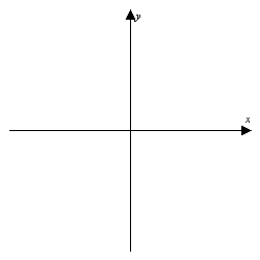
 if
if  if
if 


فتح الحزمة
افتح القفل للوصول البطاقات البالغ عددها 143 في هذه المجموعة.
فتح الحزمة
k this deck
69
Find the x-coordinates of all extrema and sketch the graph of  showing global and local behavior. Round answer to nearest thousandth.
showing global and local behavior. Round answer to nearest thousandth. 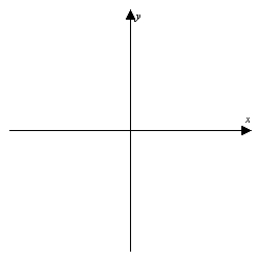
 showing global and local behavior. Round answer to nearest thousandth.
showing global and local behavior. Round answer to nearest thousandth. 

فتح الحزمة
افتح القفل للوصول البطاقات البالغ عددها 143 في هذه المجموعة.
فتح الحزمة
k this deck
70
Find the intervals where the function is increasing and decreasing. Use this information to determine all local extrema. 
A) decreasing: no extrema
no extrema
B) increasing: no extrema
no extrema
C) decreasing: increasing:
increasing:  local minimum:
local minimum: 
D) decreasing: increasing:
increasing:  local minimum:
local minimum: 

A) decreasing:
 no extrema
no extremaB) increasing:
 no extrema
no extremaC) decreasing:
 increasing:
increasing:  local minimum:
local minimum: 
D) decreasing:
 increasing:
increasing:  local minimum:
local minimum: 

فتح الحزمة
افتح القفل للوصول البطاقات البالغ عددها 143 في هذه المجموعة.
فتح الحزمة
k this deck
71
Find the x-coordinates of all extrema and sketch the graph of  showing global and local behavior.
showing global and local behavior. 
 showing global and local behavior.
showing global and local behavior. 

فتح الحزمة
افتح القفل للوصول البطاقات البالغ عددها 143 في هذه المجموعة.
فتح الحزمة
k this deck
72
Find the intervals where the function is increasing and decreasing on the specified interval. Use this information to determine all local extrema.  on
on 
 on
on 

فتح الحزمة
افتح القفل للوصول البطاقات البالغ عددها 143 في هذه المجموعة.
فتح الحزمة
k this deck
73
Determine, by hand, all critical numbers of  and use the First Derivative Test to classify each as a local minimum, local maximum or neither.
and use the First Derivative Test to classify each as a local minimum, local maximum or neither.
A) local maximum at
Local minimum at
Neither:
B) local maximum at
Local minimum at
Neither:
C) local maximum at
Local minimum at
Neither:
D) local maximum at
Local minimum at
Neither:
 and use the First Derivative Test to classify each as a local minimum, local maximum or neither.
and use the First Derivative Test to classify each as a local minimum, local maximum or neither.A) local maximum at

Local minimum at

Neither:

B) local maximum at

Local minimum at

Neither:

C) local maximum at

Local minimum at

Neither:

D) local maximum at

Local minimum at

Neither:


فتح الحزمة
افتح القفل للوصول البطاقات البالغ عددها 143 في هذه المجموعة.
فتح الحزمة
k this deck
74
Determine, by hand, the interval(s) where  is increasing and/or decreasing.
is increasing and/or decreasing.
A) increasing ; decreasing
; decreasing 
B) increasing and
and  ; decreasing
; decreasing  and
and 
C) increasing and
and  ; decreasing
; decreasing  and
and 
D) increasing and
and  ; decreasing
; decreasing 
 is increasing and/or decreasing.
is increasing and/or decreasing.A) increasing
 ; decreasing
; decreasing 
B) increasing
 and
and  ; decreasing
; decreasing  and
and 
C) increasing
 and
and  ; decreasing
; decreasing  and
and 
D) increasing
 and
and  ; decreasing
; decreasing 

فتح الحزمة
افتح القفل للوصول البطاقات البالغ عددها 143 في هذه المجموعة.
فتح الحزمة
k this deck
75
Find all critical numbers and use the First Derivative Test to classify each as a local maximum, local minimum, or neither. 
A) critical point:
 (local maximum)
(local maximum)
B) critical point:
 (local minimum)
(local minimum)
C) critical points:

 (local minimum),
(local minimum),  (local maximum)
(local maximum)
D) critical points:


 (local minimum),
(local minimum),  (neither),
(neither),  (local maximum)
(local maximum)

A) critical point:

 (local maximum)
(local maximum)B) critical point:

 (local minimum)
(local minimum)C) critical points:


 (local minimum),
(local minimum),  (local maximum)
(local maximum)D) critical points:



 (local minimum),
(local minimum),  (neither),
(neither),  (local maximum)
(local maximum)
فتح الحزمة
افتح القفل للوصول البطاقات البالغ عددها 143 في هذه المجموعة.
فتح الحزمة
k this deck
76
Find the intervals where the function is increasing and decreasing. Use this information to determine all local extrema. 
A) decreasing: increasing:
increasing:  local maximum
local maximum 
B) decreasing: increasing:
increasing:  local minimum
local minimum 
C) decreasing: no extrema
no extrema
D) increasing: no extrema
no extrema

A) decreasing:
 increasing:
increasing:  local maximum
local maximum 
B) decreasing:
 increasing:
increasing:  local minimum
local minimum 
C) decreasing:
 no extrema
no extremaD) increasing:
 no extrema
no extrema
فتح الحزمة
افتح القفل للوصول البطاقات البالغ عددها 143 في هذه المجموعة.
فتح الحزمة
k this deck
77
Find all asymptotes and extrema and sketch a graph. 


فتح الحزمة
افتح القفل للوصول البطاقات البالغ عددها 143 في هذه المجموعة.
فتح الحزمة
k this deck
78
Find all asymptotes and extrema and sketch a graph. 


فتح الحزمة
افتح القفل للوصول البطاقات البالغ عددها 143 في هذه المجموعة.
فتح الحزمة
k this deck
79
Determine, by hand, all critical numbers of  and use the First Derivative Test to classify each as a local minimum, local maximum or neither.
and use the First Derivative Test to classify each as a local minimum, local maximum or neither.
A) local maximum at
Local minimum at
Neither at
B) local maximum at
Local minimum at
Neither at
C) local maximum:
Local minimum:
Neither at
D) local maximum:
Local minimum:
Neither at
 and use the First Derivative Test to classify each as a local minimum, local maximum or neither.
and use the First Derivative Test to classify each as a local minimum, local maximum or neither.A) local maximum at

Local minimum at

Neither at

B) local maximum at

Local minimum at

Neither at

C) local maximum:

Local minimum:

Neither at

D) local maximum:

Local minimum:

Neither at


فتح الحزمة
افتح القفل للوصول البطاقات البالغ عددها 143 في هذه المجموعة.
فتح الحزمة
k this deck
80
Determine the intervals where  is concave up and concave down.
is concave up and concave down.
A) concave down for
Concave up for
B) concave down for
Concave up for
C) concave down for
Cancave up for
D) concave down for and
and 
Concave up for
 is concave up and concave down.
is concave up and concave down.A) concave down for

Concave up for

B) concave down for

Concave up for

C) concave down for

Cancave up for

D) concave down for
 and
and 
Concave up for


فتح الحزمة
افتح القفل للوصول البطاقات البالغ عددها 143 في هذه المجموعة.
فتح الحزمة
k this deck








